During World War Two, especially in the period when Hitler had almost total control over Europe before D-Day, the tank proved itself capable in some of the most unlikely places on Earth.
After being victorious in Europe, Hitler decided to turn on his Russian allies and invade their country in a campaign named Operation Barbarossa (Unternehmen Barbarossa, in honor of Frederick Barbarossa I, Holy Roman Emperor) that began on June 22nd 1941. Again, Hitler’s army employed a lightning-fast invasion with panzers at the forefront of the action. The panzer army was truly enormous, with its front line stretching all the way from the Black Sea to the Baltic Sea, some 2000 miles (3218 km), leaving no space for the Red Army to break out. Everywhere the panzers advanced the Red Army retreated, losing in excess of 3000 tanks in the process. By fall the same year 550 miles had been covered by the German army, who by then occupied half a million square miles (1.3 million sq km) of Soviet territory. The assault created 2.5 million Russian casualties and the Germans had taken over one million people prisoner.
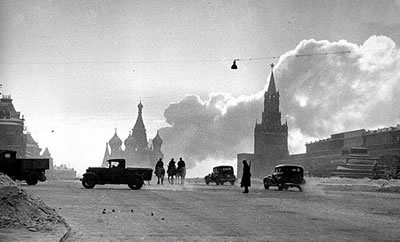 However, the weather in Russia rapidly deteriorates from August onwards, turning unpaved roads into thick, deep mud with cold rains that eventually turn into snow by early winter when everything freezes over. At first the mud practically slowed the German army to a halt when they were trying to invade Moscow, then the freezing weather hardened the ground so they were able to move again, but not for long as blinding blizzards began in early December. It is said that more Germans lost their lives to frostbite and disease during this time than from actual battle with the Russians.
However, the weather in Russia rapidly deteriorates from August onwards, turning unpaved roads into thick, deep mud with cold rains that eventually turn into snow by early winter when everything freezes over. At first the mud practically slowed the German army to a halt when they were trying to invade Moscow, then the freezing weather hardened the ground so they were able to move again, but not for long as blinding blizzards began in early December. It is said that more Germans lost their lives to frostbite and disease during this time than from actual battle with the Russians.
Despite the initial success of the panzers and German Army during Operation Barbarossa, the mission was eventually a failure for varying reasons. It is said that the start of Operation Barbarossa was put back a month to go and fight in Yugoslavia, which meant the Germans were left stuck in the extreme Russian winter in the wilderness instead of within Moscow and Leningrad. That summer was also particularly wet, so the roads were in very poor condition, even by Russian standards at the time. Furthermore, the German High Command grossly underestimated the Russians themselves in many ways. They mistakenly thought the Russian leadership was weak, that the people would be slow to follow orders and sacrifice their lives for their country. The Germans also underestimated the mechanization of the Russian army, not to mention the size of the army which was more than two times larger than they’d thought. Furthermore, while the Germans were stuck, waiting for orders and better weather, the Red Army was enlisting men at a rate of one million per month.
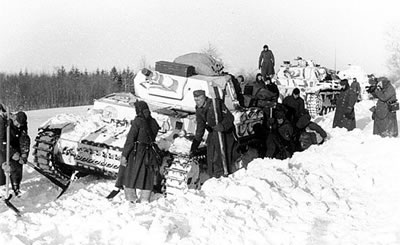 The weather played a huge part of course, especially because the Russians were used to it, planned for it and built their tanks for it. Still, some of the most brutal tank battles ever seen were during this period, right through 1942 and up until the tide of the war changed in mid 1943, in the Soviet Union. After many defeats, but with grim determination never to surrender, the Russians made a stand at Leningrad. The Hero City, as it became known later in Russia, proved impossible to crack. The Germans bombed Leningrad night and day, using tanks, soldiers artillery and aircraft, but the Red Army and Russian people were battle-hardened, fighting for their country and would never surrender or give up the fight.
The weather played a huge part of course, especially because the Russians were used to it, planned for it and built their tanks for it. Still, some of the most brutal tank battles ever seen were during this period, right through 1942 and up until the tide of the war changed in mid 1943, in the Soviet Union. After many defeats, but with grim determination never to surrender, the Russians made a stand at Leningrad. The Hero City, as it became known later in Russia, proved impossible to crack. The Germans bombed Leningrad night and day, using tanks, soldiers artillery and aircraft, but the Red Army and Russian people were battle-hardened, fighting for their country and would never surrender or give up the fight.
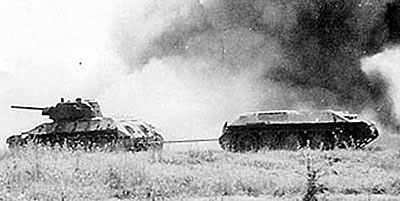 The change in the fortunes of war was never more apparent than on the Russian Steppes in mid 1943, where the Red Army began deploying their excellent new tanks, the T-34 and KV-1, in massive numbers. These new tanks had been made at secret factories to the east, away from the main fighting. They were a true rival to the German panzers, cheap and quick to make, yet robust and well-adapted for the Russian weather and terrain. The Russian tanks pushed the German Army all the way back to Germany, and eventually to the streets of Berlin. The Russian T-34 and KV-1 tanks were victorious in some of the largest tank battles the world has ever seen, perhaps the most notable being the famous battle at Kursk during July and August 1943.
The change in the fortunes of war was never more apparent than on the Russian Steppes in mid 1943, where the Red Army began deploying their excellent new tanks, the T-34 and KV-1, in massive numbers. These new tanks had been made at secret factories to the east, away from the main fighting. They were a true rival to the German panzers, cheap and quick to make, yet robust and well-adapted for the Russian weather and terrain. The Russian tanks pushed the German Army all the way back to Germany, and eventually to the streets of Berlin. The Russian T-34 and KV-1 tanks were victorious in some of the largest tank battles the world has ever seen, perhaps the most notable being the famous battle at Kursk during July and August 1943.
Tanks in the Desert
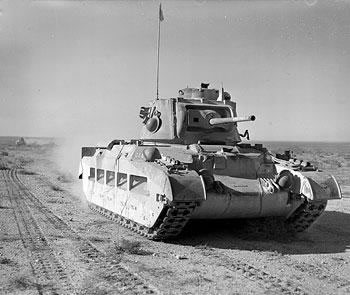 Tank battles in the desert may seem pretty normal today after two wars in Iraq and fighting in Afghanistan, but it was in World War II that the first tank battles in the desert took place. At the time no one knew how they would perform in these barren wastelands with searing heat, freezing nights and sandstorms. But, after a few adjustments, it turned out that tanks were in their element in such conditions.
Tank battles in the desert may seem pretty normal today after two wars in Iraq and fighting in Afghanistan, but it was in World War II that the first tank battles in the desert took place. At the time no one knew how they would perform in these barren wastelands with searing heat, freezing nights and sandstorms. But, after a few adjustments, it turned out that tanks were in their element in such conditions.
Many of the early desert warfare successes involved British tanks fighting against the tanks of the Italian Army, which had invaded Egypt and received a severe beating by the smaller Matilda II tanks of the British and Commonwealth forces who forced the entire 10th Italian Army back out of Egypt and made them surrender at Beda Fomm in Libya during February of 1941. During these actions the Matilda II tank became known as the “Queen of the Desert” and the British 7th Armoured Division were known as the Desert Rats. At the Battle of Beda Fomm, the British captured 20,000 enemy soldiers, masses of enemy vehicles, weapons and ammunition, and only lost the lives of nine allied soldiers and lost four allied tanks.
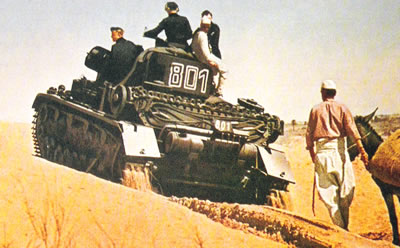 These were good times for the British in North Africa, especially after the trouncing in Northern France, but they were not to last. Or, at least, they were to be interrupted for a few years by General Erwin Rommel, the Desert Fox, and his Deutsches Afrika Korps (DAK). Rommel was a charismatic leader and expert at tank battles who found his niche in North Africa where, between March 1941 and October 1942, leading from the front where fighting is at its most fierce, he fought tank battles from one side of the Western Desert to the other. Rommel was said to be totally without fear, very insightful and full of initiative. Rommel is thought of by many as the best tank commander of any army during World War Two. He would often take personal command of individual tank units and battalions, especially if he’d spotted a mistake made by the enemy and he wanted to pounce upon them and take advantage of their shortcomings. Rommel was often seen ‘getting his hands dirty’, at the front with the lower ranks and even, at times, seen lifting mines from the sand himself. This gave him a great rapport with his men, but it also created some resentment amongst the higher ranking officers, who often couldn’t find Rommel when they needed him for critical decisions because he was off cavorting on his own private missions with some battalion or other.
These were good times for the British in North Africa, especially after the trouncing in Northern France, but they were not to last. Or, at least, they were to be interrupted for a few years by General Erwin Rommel, the Desert Fox, and his Deutsches Afrika Korps (DAK). Rommel was a charismatic leader and expert at tank battles who found his niche in North Africa where, between March 1941 and October 1942, leading from the front where fighting is at its most fierce, he fought tank battles from one side of the Western Desert to the other. Rommel was said to be totally without fear, very insightful and full of initiative. Rommel is thought of by many as the best tank commander of any army during World War Two. He would often take personal command of individual tank units and battalions, especially if he’d spotted a mistake made by the enemy and he wanted to pounce upon them and take advantage of their shortcomings. Rommel was often seen ‘getting his hands dirty’, at the front with the lower ranks and even, at times, seen lifting mines from the sand himself. This gave him a great rapport with his men, but it also created some resentment amongst the higher ranking officers, who often couldn’t find Rommel when they needed him for critical decisions because he was off cavorting on his own private missions with some battalion or other.
After many a tough battle, the British once again found their feet with the aid of General Montgomery. Many think of Montgomery as Rommel’s arch enemy which, in a way, he was. But one must not make the mistake of thinking the two men were similar, because really they could not be more different. Montgomery employed a much more hands off approach to his battles. He would carefully plan a battle, knowing exactly who and what was going to go where, then put them totally out of his mind and go to sleep at night. Many readers might find the thought of this rather strange, or even impossible, but a great demonstration of his detachment can be seen in his planning of the attack at Alam el Halfa in Egypt. Montgomery had carefully laid out all his plans for the battle at Alam el Halfa, giving specific and precise instructions to everyone involved, knowing from secret intelligence that Rommel planned to attack there, he deliberately left a gap for the German/Italian force to break though into a trap, then put the whole idea of Alam el Halfa out of his mind. While Rommel was personally leading his troops to take up position at Alam Halfa ridge for the upcoming battle, Montgomery was back at his HQ drawing up plans for the following battle of El Alamein. The Battle of El Alamein was the turning point of the war in North Africa, where Montgomery’s 8th Army defeated Rommel and forced him and the DAK all the way back, with stubborn resistance, to the neighboring country of Tunisia, where they eventually surrendered on May 12, 1943.
Tanks in the Jungle
When the Japanese bombed Pearl Harbor on December 7, 1941, they forced the Americans into the war and, ‘awaking a sleeping giant’, unleashed the largest mechanized army the world had ever seen. Almost 90,000 tanks were manufactured by America during WWII, which was nearly four times the numbers built by Britain or Germany during the same period.
A large proportion of America’s 12 million strong force were deployed to the Pacific, fighting a bitter battle from one island to another, forcing the Japanese back northward to Japan one island at a time. British and Commonwealth forces also engaged the Japanese through Burma (Myanmar) to the west of the Japanese Empire.
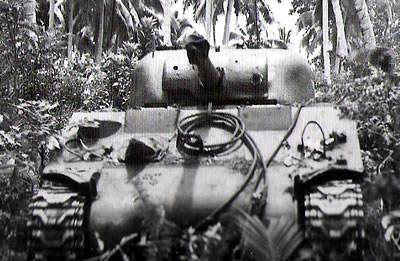 Both allied forces used tanks to great effect through harsh jungle and humid conditions, bombarding the enemy and flushing them out of bunkers with specially adapted flame-tanks. Japanese experiments with tanks were not very successful during WWII, so on land they fought mostly on foot with artillery and well-dug bunkers and underground passages. The Japanese proved extremely resilient fighters, forcing the allies to fight very hard for every scrap of ground and island, still fighting three months after victory had been achieved in Europe and Hitler was dead. It is thought the war with Japan would have lasted far longer, killing many more millions of soldiers on both sides, if it hadn’t been for the controversial use of the atom bombs on Nagasaki and Hiroshima that cause the Japanese to surrender on August 14 1945. The American Sherman tank had performed amazingly in Europe, and it also did unexpectedly well in the jungles of the pacific, but they would have had a very hard time invading and capturing the mountainous, volcanic landscape of Japan’s main islands.
Both allied forces used tanks to great effect through harsh jungle and humid conditions, bombarding the enemy and flushing them out of bunkers with specially adapted flame-tanks. Japanese experiments with tanks were not very successful during WWII, so on land they fought mostly on foot with artillery and well-dug bunkers and underground passages. The Japanese proved extremely resilient fighters, forcing the allies to fight very hard for every scrap of ground and island, still fighting three months after victory had been achieved in Europe and Hitler was dead. It is thought the war with Japan would have lasted far longer, killing many more millions of soldiers on both sides, if it hadn’t been for the controversial use of the atom bombs on Nagasaki and Hiroshima that cause the Japanese to surrender on August 14 1945. The American Sherman tank had performed amazingly in Europe, and it also did unexpectedly well in the jungles of the pacific, but they would have had a very hard time invading and capturing the mountainous, volcanic landscape of Japan’s main islands.
A few ‘experts’ of the time thought the nuclear age might see the end of the tank, but the truth is tanks are used more today than ever before and, in fact, in a post-nuclear strike the modern tank would be one of the few vehicles able to withstand the radioactive landscape of bombed cities and battlefields.